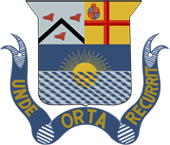
Presidency College is an art, commerce, and science college in the city of Chennai in Tamil Nadu, India. On 16 October 1840, this school was established as the Madras Preparatory School before being repurposed as a high school, and then a graduate college. The Presidency College is one of the oldest government arts colleges in India. It is one of two Presidency Colleges established by the British in India, the other being the Presidency College, Kolkata.
Brahmo Samaj is the societal component of Brahmoism, which began as a monotheistic reformist movement that appeared during the Bengal Renaissance.
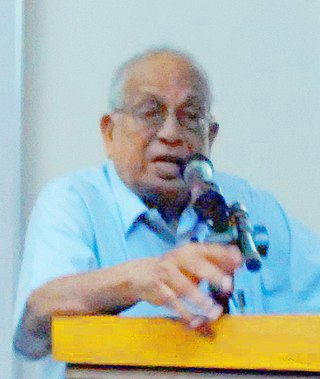
Subbiah Muthiah was an Indian writer, journalist, cartographer, amateur historian and heritage activist known for his writings on the political and cultural history of Chennai city. He was the founder of the fortnightly newspaper Madras Musings and the principal organizer of the annual Madras Day celebrations. Muthiah was also the founder-President of the Madras Book Club.

Maravar are a Tamil community in the state of Tamil Nadu. These people are one of the three branches of the Mukkulathor confederacy. Members of the Maravar community often use the honorific title Thevar. They are classified as an Other Backward Class or a Denotified Tribe in Tamil Nadu, depending on the district.

The Sadharan Brahmo Samaj or Universal Brahmo Samaj is a division of Brahmoism formed as a result of schisms in the Brahmo Samaj first in 1866 and then another in 1878.
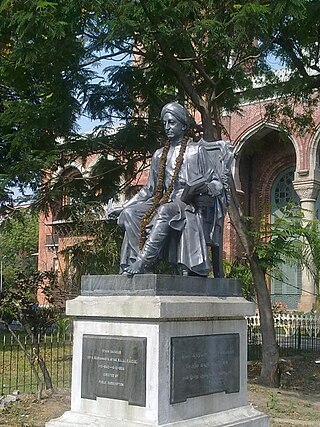
Sir Subbier Subramania Iyer was an Indian lawyer, jurist and freedom fighter who, along with Annie Besant, founded the Home Rule Movement. He was popularly known as the "Grand Old Man of South India".
Adi Dharm refers to the religion of Adi Brahmo Samaj the first development of Brahmoism and includes those Sadharan Brahmo Samajists who were reintegrated into Brahmoism after the second schism of 1878 at the instance of Devendranath Tagore. This was the first organised casteless movement in British India and reverberated from its heart of Bengal to Assam, Bombay State, Punjab and Madras, Hyderabad, and Bangalore.
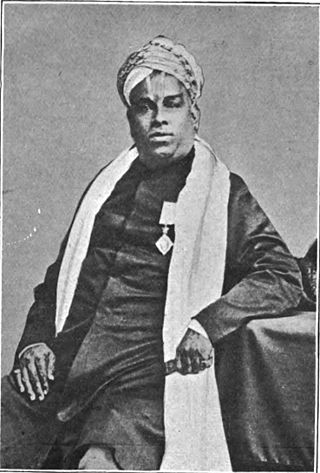
Vembaukum RamiengarCSI, also rendered Vembakkam and Rama Iengar, was an Indian civil servant, administrator, and statesman who served Sir Visakham Thirunal Rama Varma V, Maharaja of Travancore and his successor Sir Mulam Thirunal Rama Varma VI, as Diwan of Travancore from 1880 to 1887 after a lengthy career in governance in the Madras Presidency, culminating in his membership of the Madras Legislative Council from 1867 to 1879. He was a trustee of Pachaiyappa's Charities, and a member of the powerful and accomplished Vembaukum clan of Vadakalai Iyengar Brahmins originating in Vembakkam, which also produced or encompassed such contemporaries as lawyers V. Sadagopacharlu and V. Rajagopalacharlu, and Sir V. Bhashyam Aiyangar; Mysore Dewan C. V. Rungacharlu; and Madras Deputy Superintendent of Police V. Raghavachariar.

Diwan Bahadur SirVembakkam Bhashyam AiyangarKt. was a lawyer and jurist who served as the first Indian Advocate-General of the Madras Presidency and later, as a Justice of the High Court of Madras.
The Constitution Act, 1951, enacted in 1951, made several changes to the Fundamental Rights provisions of the Indian constitution. It provided means to restrict freedom of speech and expression, validation of zamindari abolition laws, and clarified that the right to equality does not bar the enactment of laws which provide "special consideration" for weaker sections of society.
Sir Vembakkam Comanduru Desikachariar was an Indian lawyer, politician and Indian independence activist who served as a member of the Madras Legislative Council from 1904 to 1908.
Vembaukum Sadagopacharlu was an Indian lawyer, jurist, banker, and statesman, who was the first native Indian member of the Madras Legislative Council, serving from 1861 to until his 1863 death, and one of the first Indians to achieve wealth and renown in the courts of British India, doing both alongside his brother, religious reformer and minor polymath V. Rajagopalacharlu, in the judicial system of the Madras Presidency, in which they were leading Vakils, he himself being the first Indian to become one. He belonged to the influential Vembaukum family.
Below is a timeline of Adi Dharm or Adi Brahmo Samaj.
Vijaya Kamlesh Tahilramani is a former Indian judge and prosecutor, who last served as the Chief Justice of the Madras High Court. Previously, as a judge of the Bombay High Court, she notably upheld the conviction of several persons for the rape of a pregnant Muslim woman during the 2002 Gujarat riots, chastising investigative authorities for their inaction in the matter, and also refused parole for those convicted in the 1993 Bombay bombings. She retired in 2019, after refusing to accept a controversial transfer from the Madras High Court to the Meghalaya High Court.

The Madras High Court is a High Court in India. It has appellate jurisdiction over the state of Tamil Nadu and the union territory of Puducherry. It is located in Chennai, and is one of the oldest high courts of India along with Calcutta High Court in Kolkata and Bombay High Court in Mumbai. The Madras High Court is one of four charter high courts of colonial India established in the four Presidency Towns of Madras, Bombay, Allahabad and Calcutta by letters patent granted by Queen Victoria, dated 26 June 1862. It exercises original jurisdiction over the city of Chennai, as well as extraordinary original jurisdiction, civil and criminal, under the letters patent and special original jurisdiction for the issue of writs under the Constitution of India. Covering 107 acres, the court complex is one of the largest in the world, second only to the Supreme Court of the United Kingdom. The four-storey administrative building attracts hundreds of litigants every day.
G. R. Swaminathan is an Indian judge of the Madras High Court.

The Vembaukum or Vembakkam family were one of the two preeminent Brahmin dynasties in the Madras Presidency, dominating the Mylapore clique alongside the Calamur clan, and 'possess(ing) an enormous presence in the... bureaucracy of the capital and its surrounding district(s)', whose historical presence began in the 1820s, with the sprawling clan famously having begun holding yearly family conferences by the 1890s to preserve their dynastic unity, political cohesion and influence, and wealth.
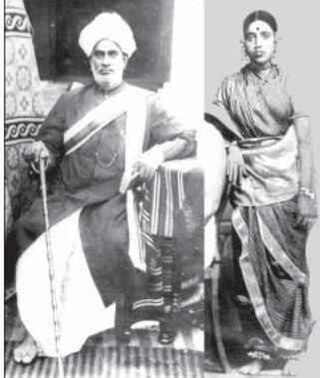
Chetpet Ramaswamy Pattabhirama Iyer, surname alternately spelt Aiyar, originally surnamed Dikshitar, was an Indian lawyer and jurist, noted for having led the Tanjore Bar and served as the Tanjore public prosecutor, before relocating to the city of Madras, whereupon he ultimately became a Vakil of the High Court of Madras, central member of the Mylapore clique, and a leader of the Madras bar, along with M. O. Parthasarathy Iyengar, V. Krishnaswamy Iyer, P. R. Sundaram Iyer, Sir V. C. Desikachariar, and Sir C. Sankaran Nair, immediately behind Sir V. Bhashyam Aiyangar and Sir S. Subramania Iyer, from 1891.

Calamur Viravalli Sundara Sastri was a leading Vakil of the High Court of Madras, second in the Calamur line to bear the style Viravalli, and of a family line occupying a prominent position and status within the Madras Presidency; a "giant" of Madras jurisprudence, with a "very large" practice on the Original Side, which he shared with his partner and adoptive brother, Sir P. Ananda Charlu. Sundara Sastri published a Revised Set of the Rules of Practice for Original side litigation, which became de rigueur, and was noted as an orator with 'perfect' diction. He authored the Sundararāmāyaṇa.









